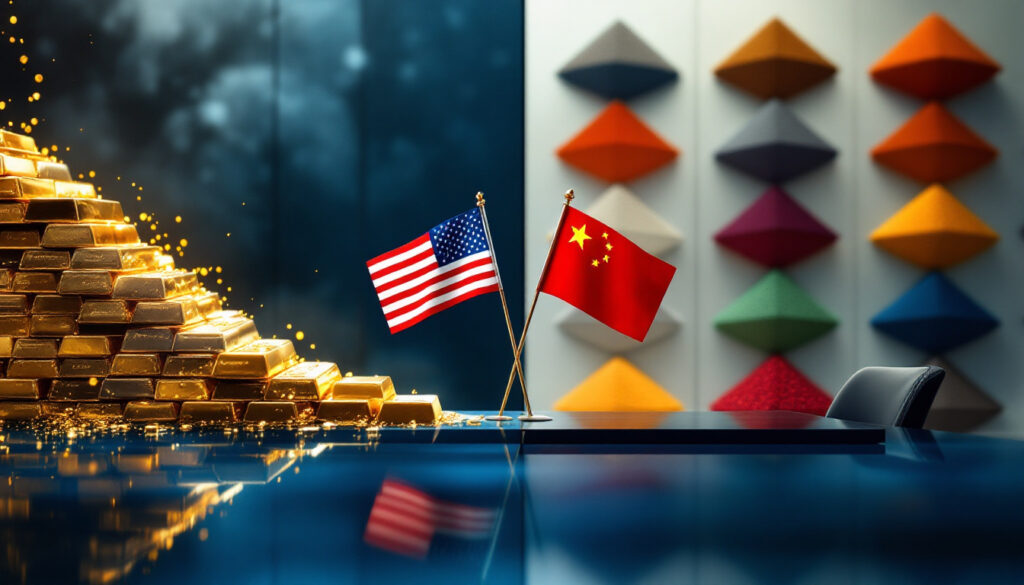US-China Trade Truce: Market Impacts and Industry Implications
The recent US-China trade truce, marked by a 90-day tariff reduction agreement, has triggered significant market reactions and strategic shifts across industries. Gold prices plunged nearly 3% to $3,235 per ounce, reflecting reduced safe-haven demand as investors pivoted toward equities. China's rare earth trade strategy remains a critical lever in negotiations, with Tesla engaging Chinese authorities to secure supplies for its Optimus robot production. Corporate responses vary, from The Metals Company's $51 million CAD seabed mining initiative to Hester's divestment from Mineral Resources over governance concerns. Environmental debates intensify as seabed mining permits advance, while analysts caution that the US and China trade truce is a tactical pause rather than a resolution.
What Is the Recent US-China Trade Truce?
Understanding the 90-Day Tariff Reduction Agreement
The US and China agreed to reduce tariffs to 30% during negotiations in Geneva, establishing a 90-day cooling period amid protracted trade tensions. This interim measure aims to stabilize bilateral trade relations while deferring structural disagreements, such as intellectual property disputes and market access barriers. The partial reduction—rather than full elimination—reflects mutual caution, preserving negotiating leverage for both nations.
Historically, such temporary agreements have preceded prolonged talks, as seen during the 2018–2020 trade war, though their efficacy remains contingent on political will. Economic analysts view this as a strategic pause rather than a fundamental shift in policy direction from either nation.
Key Elements of the Trade Agreement
The agreement's limited scope focuses on immediate economic relief, particularly for sectors disproportionately impacted by tariffs investment impact, such as consumer electronics and agricultural exports. By avoiding mention of technology transfer or subsidy reforms, the deal sidesteps contentious issues, prioritizing short-term market stability.
However, the absence of enforcement mechanisms raises questions about compliance, mirroring challenges in prior agreements. The temporary nature of the arrangement suggests both sides are keeping options open while assessing domestic economic conditions and political considerations, according to a recent CNBC analysis.
How Has the Trade Truce Affected Gold Markets?
Immediate Gold Price Reactions
Spot gold fell 3% to $3,235 per ounce post-announcement, its lowest in a month, while US gold futures declined by $12 to $3,241. This sharp correction reversed a three-week rally driven by earlier geopolitical uncertainties, underscoring gold's sensitivity to trade sentiment.
The sell-off accelerated as hedge funds slashed bullish positions to 12-month lows, diverting capital to equities and the dollar. Technical analysts note the breach of key support levels could trigger further liquidation if prices remain below $3,250 for consecutive sessions.
Market Sentiment Shifts and Investment Trends
Risk appetite resurged, with the S&P 500 gaining 2.1% in the week following the truce, as investors priced in reduced near-term volatility. The dollar index rose 0.8%, pressuring dollar-denominated gold further.
However, analysts note that gold's long-term appeal persists, given unresolved structural issues in US-China relations and inflationary pressures. As one senior commodity strategist put it:
"The current sell-off represents a tactical repositioning rather than strategic abandonment of gold. Institutional investors maintain core allocations while trimming speculative positions."
Correlation Between Trade Relations and Safe-Haven Assets
Gold's inverse relationship with trade optimism highlights its role as a barometer for geopolitical risk. During the 2018–2019 trade war, gold prices surged 18% amid escalating tariffs, only to retreat 11% following the Phase One deal.
This pattern suggests that prolonged truce extensions could suppress gold prices, while any breakdown in talks would reignite demand. Historically, gold price volatility increases by 35% during periods of trade uncertainty, making the metal a reliable indicator of diplomatic progress. For more detailed insights, recent gold price analysis shows continuing market trends.
What Are the Implications for Rare Earth Minerals?
China's Rare Earth Export Controls
In April, China mandated export licenses for seven rare earth minerals—including neodymium and dysprosium—critical for electric vehicles (EVs) and defense systems. These controls, affecting 80% of global supply, aim to consolidate China's dominance amid US efforts to diversify sources.
The policy aligns with China's 2021 Strategic Minerals Catalog, which prioritizes resource security. China's rare earth production accounts for:
| Element | Global Market Share | Primary Applications |
|---|---|---|
| Neodymium | 85% | EV motors, wind turbines |
| Dysprosium | 92% | Defense systems, data storage |
| Terbium | 87% | Solid-state lighting, sonar |
| Praseodymium | 81% | Glass manufacturing, magnets |
Potential Changes Under the Trade Truce
While expedited permits may temporarily ease supply chain bottlenecks, China is unlikely to lift restrictions entirely, preserving leverage. Tesla's negotiations for long-term supply contracts reflect corporate strategies to mitigate dependency, though alternative sourcing remains nascent.
Industry experts anticipate:
- Faster processing of existing permit applications
- Potential quota increases for non-sensitive applications
- Maintained scrutiny for defense-related exports
- Gradual normalization of trading volumes over the 90-day period
Impact on US Technology and Defense Industries
The US imports over 70% of its rare earths from China, with defense applications accounting for 15% of consumption. Delays in processing licenses since April have disrupted production timelines for F-35 components and EV motors, prompting stockpiling initiatives.
The Department of Defense recently allocated $1.2 billion to onshore rare earth processing, signaling strategic realignment. Companies including Lynas Rare Earths and MP Materials have received grants to establish domestic supply chains, though full operationalization remains 3-5 years away.
How Are Corporate Players Responding to the Trade Developments?
Tesla's Strategic Moves
Elon Musk's direct engagement with Chinese regulators seeks to secure neodymium supplies for Optimus robots, which require 2.3 kg of rare earths per unit. Tesla aims to lock in three-year contracts, mirroring Apple's 2022 cobalt sourcing strategy, to insulate production from trade volatility.
The company's approach includes:
- Direct negotiations with Chinese suppliers
- Investment in recycling technologies to recover rare earths
- Research into alternative motor designs requiring fewer critical minerals
- Strategic stockpiling of key materials
The Metals Company's Funding and Exploration
The Metals Company (TMC) secured $51 million CAD for polymetallic nodule benefits in the Clarion Clipperton Zone, aiming to produce nickel, cobalt, and copper. Shares rose 6.7%, valuing TMC at $1.1 billion CAD, though environmental groups oppose deep-sea mining's ecological impact.
TMC's exploration targets nodules containing:
- 1.3% nickel (comparable to land-based deposits)
- 0.2% cobalt (higher concentration than terrestrial mines)
- 29% manganese (essential for steel production)
- 1.1% copper (critical for electrification)
Mineral Resources' Governance Challenges
Hester's divestment of its $14 million AUD stake underscores mounting investor scrutiny of governance. The resignation of two ethics committee directors and unresolved allegations against founder Chris Ellison have eroded confidence, despite board restructuring pledges.
This case illustrates how ESG considerations increasingly influence investment decisions in the mining sector, with institutional investors demanding greater transparency and accountability. The divestment follows a pattern of pension funds prioritizing governance alongside environmental factors.
What Are the Environmental and Regulatory Considerations?
Seabed Mining Controversies
TMC's permit application, filed under a US executive order fast-tracking offshore mining, targets 3.8 million tons of nodules annually. Marine biologists warn that sediment plumes could smother benthic ecosystems, citing 2023 studies showing a 40% decline in abyssal species near test sites.
The deep sea mining controversy centers on several key issues:
- Sediment plumes may travel hundreds of kilometers, affecting wide areas
- Biodiversity impacts on deep-sea organisms, many still undiscovered
- Carbon sequestration disruption as seafloor sediments are disturbed
- Noise pollution affecting marine mammals' communication systems
Regulatory Landscape Evolution
The International Seabed Authority (ISA) is drafting exploitation codes, balancing resource demand against biodiversity mandates. Meanwhile, the EU's Critical Raw Materials Act mandates 15% domestic recycling by 2030, pressuring firms to adopt circular supply chains.
This regulatory evolution reflects broader tensions between securing strategic resources and environmental protection, with mining companies advocating for streamlined permitting while conservation groups push for moratoriums on new extraction projects.
What Are the Long-Term Implications of the Trade Truce?
Market Analysts' Perspectives
The 90-day window offers limited respite, with structural issues like semiconductor restrictions and South China Sea tensions unresolved. Analysts at Goldman Sachs have reduced US recession odds to 35%, citing improved trade conditions.
Key factors influencing long-term outcomes include:
- US presidential election dynamics
- China's economic recovery trajectory
- Alternative supply chain development progress
- Technological competition in strategic sectors
Strategic Resource Considerations
Rare earths will remain central to US-China competition, as both nations invest in supply chain resilience. China's $15 billion rare earth consolidation fund and the US's Defense Production Act allocations exemplify this prioritization.
The temporary nature of the current agreement suggests that critical minerals will continue to feature prominently in trade negotiations, with market volatility likely during transition periods. Companies with diversified supply chains may gain competitive advantages as geopolitical considerations increasingly influence sourcing decisions.
FAQs About the US-China Trade Truce
How long will the US-China trade truce last?
The tariff reduction lasts 90 days, though extensions are possible if negotiations progress. Historical precedents suggest that temporary agreements often serve as platforms for more comprehensive discussions, though success depends on political will from both sides.
Will China completely remove rare earth export restrictions?
Unlikely; expedited permits may occur, but strategic controls will persist. China views rare earths as leverage in broader trade discussions and has invested significantly in supply chain consolidation to maintain market dominance.
How has the trade truce affected investment strategies?
Investors shifted from gold to equities, though long-term portfolio diversification continues. Many institutional investors maintain core precious metals positions while adjusting tactical allocations to capitalize on improved risk sentiment.
What industries are most affected by rare earth supply issues?
EVs, renewables, and defense sectors face acute vulnerability due to rare earth dependency. Each Tesla Model 3 contains approximately 4.5 kg of rare earth elements, while a single F-35 fighter jet requires over 420 kg for various components.
How are mining companies responding to the changing trade landscape?
Strategies range from direct negotiations to alternative sourcing, including deep-sea mining. Companies are also investing in recycling technologies, with some achieving up to 35% recovery rates from electronic waste streams.
Further Exploration
For ongoing updates on trade impacts, mining.com provides real-time analysis of policy and market trends affecting the resources sector.
Want to Spot the Next Major ASX Discovery?
Discovery Alert's proprietary Discovery IQ model instantly notifies you when significant mineral discoveries are announced on the ASX, providing actionable insights before the broader market reacts. Visit our discoveries page to see how historic mineral finds have generated substantial returns for early investors.




